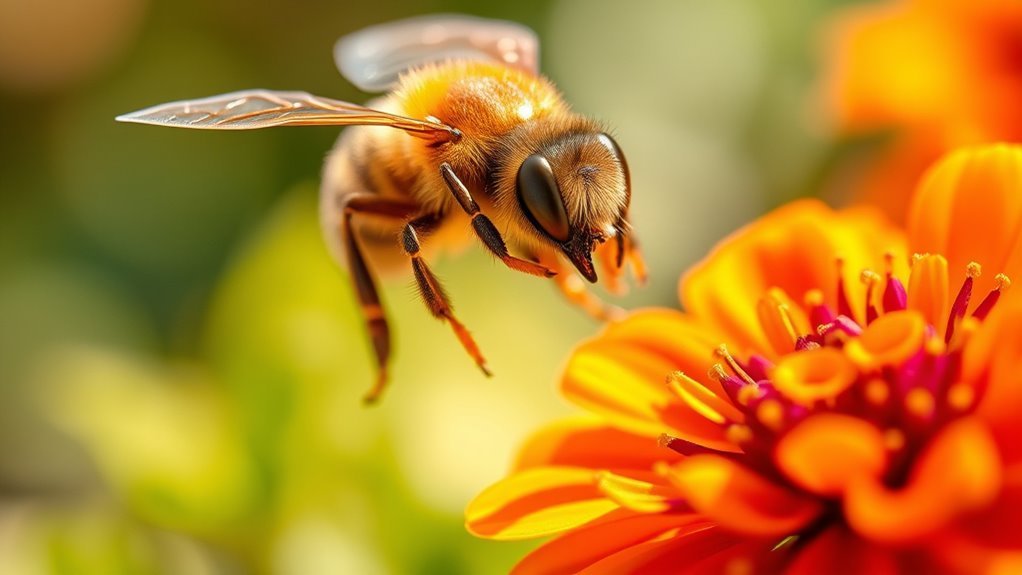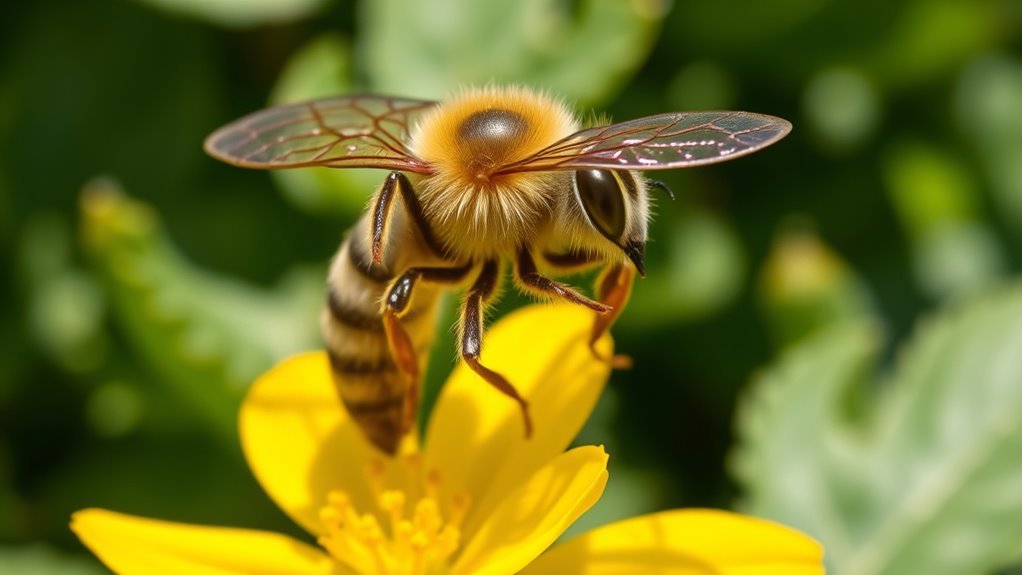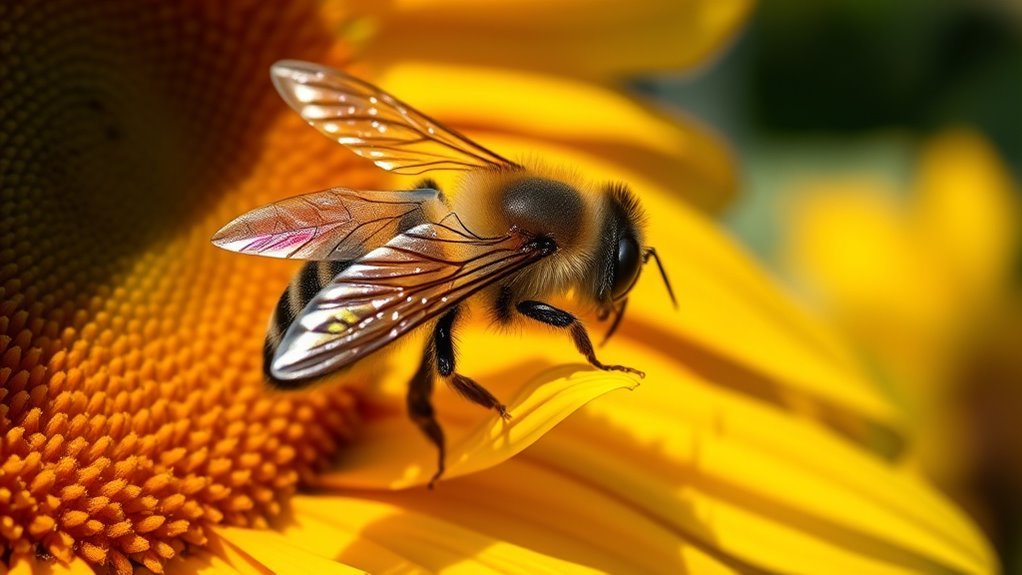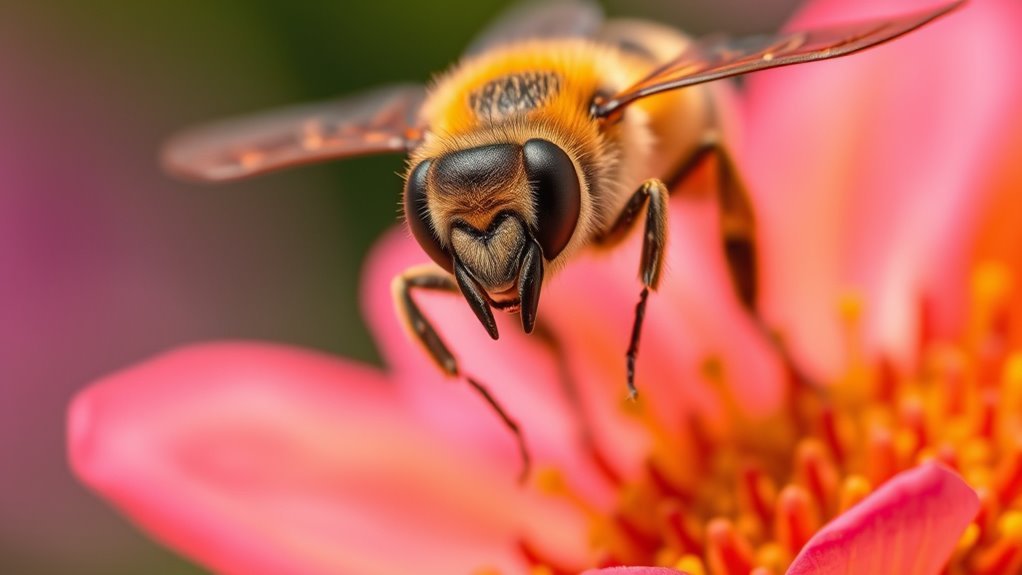Drone bees don’t sting, which sets them apart from worker bees. Unlike their female counterparts, drones lack stingers entirely, focusing solely on reproduction rather than defense. This absence of a stinger makes them harmless to humans and other creatures. While drones may seem less active, they play an essential role in mating with the queen to guarantee genetic diversity within the colony. If you’re curious about the fascinating lives of these bees, there’s much more to discover.
Understanding Drone Bees

Drone bees, often overlooked in discussions about honeybee behavior, play an essential role in the hive’s reproductive cycle. Unlike worker bees, drones are male and exist primarily for drone reproduction. Their main purpose is to mate with a queen during a brief window in her life, ensuring genetic diversity within the hive. Understanding drone reproduction is vital for grasping hive dynamics, as the presence and health of drones can influence the colony’s overall stability. When the queen is absent or failing, the hive can become disorganized, impacting not only reproduction but also resource allocation. By recognizing the significance of drones, you’ll appreciate their contribution to maintaining a thriving honeybee community, ultimately supporting ecological balance.
The Anatomy of Drone Bees

Understanding the anatomy of drone bees is essential for appreciating their unique role within the hive. Drone bee morphology differs markedly from worker bees, as drones have larger bodies and bigger eyes, which help them locate queens during mating flights. Their primary function revolves around reproduction; drones don’t gather nectar or pollen. Instead, they possess specialized reproductive organs that enable successful mating with a queen. These organs are vital for genetic diversity within the colony. Drones emerge from unfertilized eggs, a process known as parthenogenesis, further emphasizing their reproductive role. By understanding these anatomical features, you can grasp how drone bees contribute to the hive’s overall health and genetic viability, ensuring the continuation of their species.
The Role of Drone Bees in the Hive

Within the hive, drone bees play a crucial role in ensuring the colony’s reproductive success. Unlike worker bees, drones are solely focused on mating with a queen during specific mating rituals. Their presence is essential for genetic diversity, which contributes to the colony’s resilience and adaptability. The dynamics in the hive shift as drones are bred during peak seasons, emphasizing their significance in reproduction. While they don’t gather nectar or pollen, their role in mating helps sustain the hive’s population. After mating, drones often face expulsion from the hive, highlighting the harsh realities of hive dynamics. Understanding their contributions allows you to appreciate the intricate balance within the bee community and the significance of each member’s role.
Do Drone Bees Have Stingers?
When examining drone bee anatomy, you might wonder about their stinger functionality. Unlike worker bees, drone bees lack stingers entirely, which sets them apart regarding defense mechanisms. Understanding this anatomical difference highlights the specific roles drone bees play within the hive compared to their worker counterparts.
Drone Bee Anatomy
Drone bees, unlike their female counterparts, lack the capability to sting. This absence is a key feature of their anatomy, distinguishing them from worker bees and queens. Understanding drone bee anatomy helps clarify their role in the hive. Here are some notable drone bee features:
- Larger Size: Drones are typically larger than worker bees, with a more robust body structure.
- Eyes: They possess large, compound eyes that enhance their vision, aiding in mating flights.
- Reproductive Organs: Drones have well-developed reproductive systems, designed specifically for mating.
These anatomical traits emphasize the drone’s primary function within the colony: reproduction. Without stingers, drone bees contribute to the hive’s ecosystem without posing a threat to humans or other creatures.
Stinger Functionality Explained
While many people associate bees with stinging, it’s essential to highlight that drone bees, unlike their worker counterparts, don’t possess stingers at all. This absence is a result of stinger evolution, where drones have developed different roles within the hive. Their primary function revolves around mating, not defense. Worker bees, tasked with protecting the colony, possess stingers as part of their defensive mechanisms. In contrast, drone bees prioritize reproduction, thereby eliminating the need for a stinger. This evolutionary divergence allows the hive to focus resources on nurturing workers equipped for survival, rather than on drones that contribute to gene propagation. Understanding these distinctions sheds light on the diverse roles bees play in their ecosystem.
Comparison With Worker Bees
Although many people might assume all bees can sting, a clear comparison between drone bees and worker bees reveals significant differences. Here are three key points highlighting the drone bee comparison and worker bee differences:
- Stinger Presence: Worker bees have stingers, which they use for defense. Drones, however, lack stingers entirely.
- Role in the Hive: Worker bees maintain the hive, gather food, and protect the colony. Drones exist primarily for mating and have no other functional roles.
- Lifespan: Worker bees typically live several weeks to a few months, while drones usually die shortly after mating or are expelled from the hive before winter.
Understanding these distinctions clarifies why drone bees pose no threat regarding stinging, contributing to a peaceful coexistence with humans.
The Behavior of Drone Bees
Understanding the behavior of drone bees is essential for appreciating their role within the hive. Unlike worker bees, drones primarily focus on mating, which shapes their behavioral patterns. They spend most of their time in flight, often congregating in specific areas known as drone congregation zones, where they await potential mates. Their social interactions are less complex than those of worker bees; they don’t engage in foraging or hive maintenance. Instead, drones rely on worker bees for sustenance and care. When the mating season ends, their fate is often sealed, as they’re expelled from the hive. This distinct lifestyle highlights their purpose: to guarantee the continuation of the colony through reproduction, emphasizing their unique place in the hive’s ecosystem.
Myths and Misconceptions About Drone Bees
Drones play a vital role in the hive, yet many myths and misconceptions surround their nature and behavior. Understanding these drone bee myths can help clarify their true function:
- Drones can sting: Unlike worker bees, drones lack a stinger, making them harmless to humans.
- Drones are lazy: While they don’t gather nectar or pollen, their primary role is to mate with the queen, which requires energy and purpose.
- Drones are unnecessary: Contrary to popular belief, drone bees are essential for genetic diversity in the colony, ensuring healthy offspring.
Frequently Asked Questions
How Do Drone Bees Mate With Queen Bees?
During the mating process, drone bees are attracted to queen pheromones. They fly to the queen, engaging in a brief courtship, before mating mid-air, ensuring genetic diversity for the hive while fulfilling their reproductive role.
What Happens to Drone Bees After Mating?
In the dance of life, drone bees live for a fleeting moment. After mating season, they’re cast aside, often meeting their end soon after. Their brief existence embodies nature’s cycle of creation and sacrifice.
Are Drone Bees Larger Than Worker Bees?
When comparing bee sizes, drone bees are generally larger than worker bees. Drone bee characteristics, including their bulkier bodies, serve specific reproductive roles, highlighting their differences in function and form within the hive’s hierarchy.
Can Drone Bees Survive Winter?
When it comes to winter survival, you might say, “A bird in the hand is worth two in the bush.” Drone bees typically don’t survive winter, as they’re often expelled from the hive before the cold sets in.
Do Drone Bees Contribute to Honey Production?
Drone bees don’t contribute to honey production. Their primary role is mating with queens, while worker bees handle nectar and pollen collection, essential for producing honey. Understanding this hierarchy clarifies the drone’s limited function in the hive.

